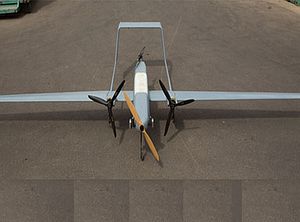Israel Aerospace Industries (IAI) and South Korean composite manufacturer, Hankuk Carbon (HC), have signed a memorandum of understanding to establish a joint venture to develop and produce new Vertical Take-Off and Landing Unnamed Aerial Vehicles (UAVs) at the beginning of February, according to Israeli media reports.
The companies said that they will start their collaboration with the development of a UAV with a 200-300 kilogram takeoff weight and aim to produce 90 percent of it in South Korea. IAI and HC are also considering jointly developing a shipborne take-off and landing capabilities for the IAI/Hankuk FE-Panther VTOL drone—a tactical UAV specifically developed to operate in Korea’s mountainous regions, and which will be available by the end of 2018.
According to Flight Global, the Panther UAV was first revealed in October 2015 and “is powered by lithium polymer batteries and a gasoline engine, and has an endurance of 8 hours with 6 kilogram payload. It has a 130km range and a maximum speed of 100km/h, and has an automatic VTOL capability.”
Israel and South Korea have first partnered up in the development of UAVs in 2014. Seoul has the ambitious plan of becoming the third technologically most advanced leader in drone technology by 2023. “By 2023, South Korean should only trail behind the United States and Israel in terms of technological prowess while ranking as the fourth largest supplier of drones as measured in sales,” the director of Korea Aerospace Research Institute, Choi Seong-wook, told Yonhap News in 2014.
“We see the upcoming JV as a great opportunity for both companies to expand their business,” Shaul Shahar, executive vice-president of IAI, said. “With Hankuk Carbon’s composite material production capability and with IAI’s 40 years of experience and knowhow of UAVs, the joint venture has the potential to become a leading VTOL UAV company, and to provide the best solution to our customers in Korea and worldwide.”
As I reported in January (See: “South Korea’s Military to Receive New Reconnaissance Drone”), Korean Air Aerospace Division signed a 400 billion won (US $ 333.5 million) deal with the Defense Acquisition Program Administration (DAPA) at the end of December last year to mass produce new reconnaissance drones. As I explained then:
The new unmanned aerial vehicle (UAV), designated KUS-FT, will be produced from 2016 to 2020 with first deliveries expected in 2018. (…) The drone was developed between 2010 and November 2014 for intelligence, surveillance and reconnaissance, as well as target acquisition missions. The KUS-FT is South Korea’s first indigenously-produced UAV to receive an air worthiness type certification.
Each division of the Republic of Korea Armed Forces is slated to receive one new UAV system, according to DAPA. One of Seoul’s principal objectives in the development of new UAVs is to enhance the South Korean military’s surveillance capabilities along the Demilitarized Zone (DMZ) in order to faster detect North Korean incursions.

































